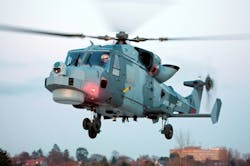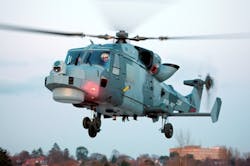AgustaWestland to integrate and test FASGW missile systems on U.K. MoD AW159 Wildcat helicopters
FARNBOROUGH, England, 16 July 2014. Officials at AgustaWestland, a Finmeccanica company, signed a contract with the U.K. Ministry of Defence (MoD) valued at £90 million to integrate, test, and install the Future Anti-Surface Guided Weapon and Light missile systems onto 28 Royal Navy AW159 Wildcat helicopters.
The MBDA Future Anti Surface Guided Weapon (Heavy)/Anti Navire Léger [FASGW(H)/ANL] and Thales Light Multirole Missile [LMM; FASGW (Light)] will be integrated onto the AW159 Wildcat to provide the ability to attack a wide range of surface targets ranging from small, high-speed surface craft up to large surface vessels, such as corvettes, as well as coastal and land targets. The “two new technology missiles…will give the Royal Navy an exceptional and flexible anti-surface warfare capability,” says an AgustaWestland spokesperson.
The AW159 Wildcat will be able to carry up to four launchers, two per weapon carrier, each with up to five LMM missiles, or up to four FASGW(H)/ANL missiles with two on each weapon carrier. It will also be able to carry a mixed load of LMM launchers and FASGW(H)/ANL missiles for maximum mission flexibility.
The MBDA FASGW(Heavy)/ANL features a high speed, two-way data-link that communicates the images “seen” by the missile’s seeker to the operator, who, in addition to initiating an autonomous engagement, can alternatively remain in control of the missile throughout the full duration of its flight. This optional, man in the loop monitor and control facility enables new capabilities such as: in-flight re-targeting; final aim point correction and refinement; and safe abort. Ultimately, the missile will be able to engage targets situated out of direct line of sight when the launch platform is able to benefit from third party target designation or laser illumination.
The Thales LMM is a lightweight, precision strike, missile that has been designed to provide a rapid reaction to a wide range of surface naval threats from small ships and fast inshore attack craft as well as on-land surface threats.
Work on this contract will be mainly completed at AgustaWestland’s facility in Yeovil which employs over 3,300 people to undertake the design, development and manufacture of helicopters and the integration of their systems, and provide through life training and support services.
The company is manufacturing 62 Wildcat helicopters for the U.K. MoD, 28 of which will be operated by the Royal Navy and 34 by the British Army. The Wildcat is replacing the Lynx helicopter and 33 of the 62 aircraft have now been delivered comprising 12 for the Royal Navy and 21 for the British Army.

